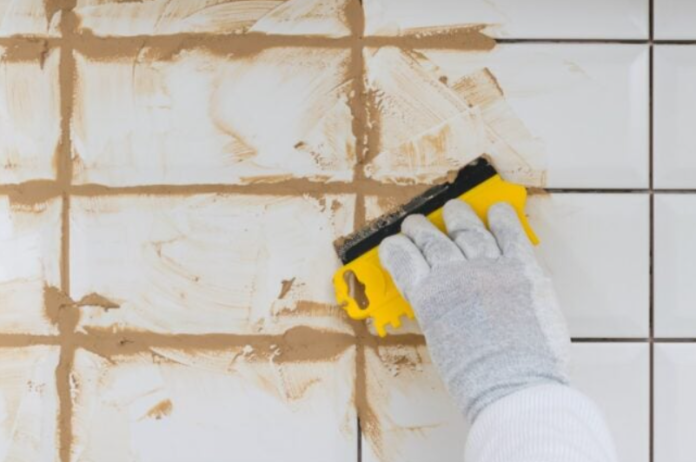Don’t mess up your next tile project. Learn how long it takes for different types of grout to dry and how moisture can affect drying time.
Question: The grout in my shower is cracking, so I decided to remove it and apply a new grout. I don’t know how long I need to let the grout dry before I can use the shower again. How long does it take for the grout to dry?
Answer: Replacing cracked grout in the shower is a smart move. Cracked grout leaves an opening for water to penetrate behind the tiles, which can cause damage and lead to mold and mildew. However, it is just as important to let the grout dry completely and harden as it is to grout the tiles.
Walking on a tiled floor where the grout has not fully dried can dislodge the tiles and disturb the grout, affecting the overall appearance of the floor and its structural integrity. Grout that has not dried properly or is wet before curing can also allow water to seep into the voids and behind the tiles. In addition, if grout is not allowed to cure sufficiently before sealing, it may chip or peel.

First, it is important to understand the difference between setting, drying and curing.
Although setting, drying and curing are related, each of these terms has a unique meaning that is important to understand before working with grout.
Setting is the process of placing the grout and applying it between tiles.
Drying is the time it takes for the grout to become dry to the touch.
Curing is the molecular change that occurs in the grout that results in a strong adhesive bond.
When working with grout, it is not enough for the grout to be dry to the touch. It is necessary to wait for the grout to harden. During hardening, water binds to the cement in what is called the hydration process. During hydration, calcium hydrate and silica crystals grow, wrap around each other and become embedded in the grout.
The grout curing process results in a durable, well-bonded structure. Part of the curing process begins when the material rests for 10 minutes after mixing and before being applied to the tiles, so it is better to use it after mixing than later or after it has been left overnight.
Drying times vary depending on the type of grout.
If you are wondering when you can shower after grouting your bathtub or shower, there is no definitive answer. The type of grout used affects the drying time. The two main types you will find are epoxy and cement-based grouts. Cement-based grouts fall into two categories: sanded and unsanded.
The answer to the question “How long should grout be left to set before cleaning?” is the same whether using epoxy or cement grout. The grout should only set for 15-30 minutes before using a damp sponge to remove excess grout. However, setting times vary from one type of grout to another. More information on each type of grout and the usual curing time can be found below. However, it is always best to consult the package instructions for the most reliable information on a specific grout product.
Sand-based grout, a type of cement-based grout, typically takes up to 72 hours to dry completely. This time may not seem ideal. However, because it takes longer to harden, sand-based grout can be a little easier to work with, especially when it comes to removing the excess that remains on top of the tiles. Be sure to apply a penetrating sealer when using sanded grout in a bathroom.

Environmental conditions can play a role in the drying time of the grout.
The type of grout you choose is only one factor that influences the overall drying time. Room humidity and temperature also contribute to the drying time of tile grout. In bathrooms with high humidity, tile grout will take longer to dry than in bathrooms with lower humidity.
Similarly, room temperature also plays a role in determining the drying and curing time of new grout or grout repairs. At the same humidity level, grout will generally dry faster in a warm room than in a cold room. Because it is much more difficult to control outdoor conditions than indoor temperature and humidity levels, the drying time for an exterior grouting project will likely be longer than for an interior project.
Reducing humidity will not speed up the drying process.
When looking for ideas to speed up grout drying time, reducing the humidity level in the room can help. By removing houseplants and using a dehumidifier, you will decrease the humidity in the air, which will reduce the drying time of the grout. However, don’t expect to see a dramatic difference.
The best advice when waiting for grout to dry and harden is to be patient. You don’t want to rush the process and end up not giving the grout enough time to cure. You could end up ruining your project.

Don’t forget the joint sealant.
In most cases, you will also need to apply a sealant to the floor and wall tile joints. This raises another question: how long does the grout need to dry before it can be sealed? It must be given time to fully cure. If a sealant is applied too soon, it may flake off and leave the grout vulnerable to water damage.
Once the sealant is applied, it should be given time to dry. While the product may feel dry to the touch after only 2 hours, it can take up to 72 hours to fully cure. Avoid using the shower, walking on the tiles or cleaning the joints, even with an approved cleaning product, until the sealant has fully cured. Always consult the manufacturer’s recommendations for the exact curing time of the sealer you plan to use.










